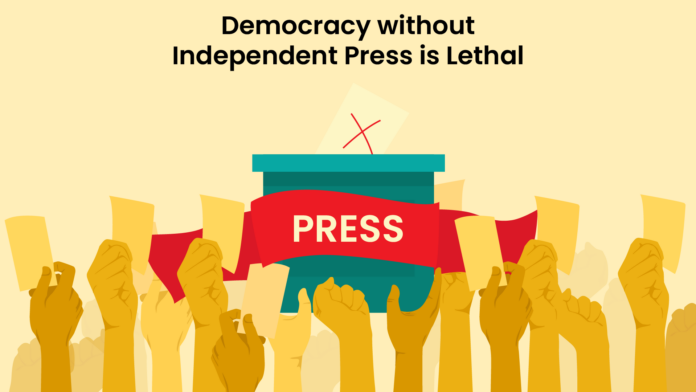Media is the fourth pillar of democracy. It not only acts as a bridge between Government and citizens it also helps to further enhance and friend then the roots of democracy in the country. It plays a significant role in generating and proliferating democratic culture in society. Media also acts as a watchdog for the citizens as it reflects and put across the wrongdoings of the state and rulers.
As Benito Mussolini said:
“Democracy is a kingless regime infested by many kings who are sometimes more exclusive, tyrannical and destructive than one if he is a tyrant”. It is the fear of being exposed by the media before the public that most of the politicians keep themselves under control to some extent”
But without power, it’s very tough to fight against the powerful. The Indian media draws its rights from the constitution of India. Though it is not explicitly mentioned yet article 19 of the Indian Constitution implicitly empowers the media. After independence Indian media has gone through various restrictions and censorship. It was not at all easy to function independently as time and again the Government of India had put restrictions on the reporting, publication, and circulation of media. Through multiple cases, Supreme Court enabled and helped the Indian media to regain and restore its might.
It sounds humorous but article 19 which empowers media, the same was used by the government on numerous occasions to curtail the rights of the same. But before we sail through the journey of cases, let’s get a glimpse of article 19 of the Indian constitution which is a fundamental right as well.
Article 19: The Right to Freedom
Article 19 talks about the Right to Freedom. Originally it contained seven rights but the right to acquire hold and dispose of the property was deleted by the 44th Amendment Act of 1978.
Article 19(1) implies that every citizen has the right to express his views opinions beliefs and convictions freely by word of mouth, writing, printing, picturing, or in any other manner. The supreme court held that freedom of speech and expression also includes:
freedom of the press, freedom of commercial advertisements, right against taping of telephonic conversations, right to telecast that the government has no monopoly over electronic media, right against the imposition of pre-censorship on a newspaper, right to demonstration or picketing but not right to strike.
Article 19(2) mentions the grounds on which the state can impose reasonable restrictions on the exercise of freedom of speech and expression. It includes sovereignty and integrity of India, security of the state, friendly relations with foreign States, public order, decency or morality, contempt of court, defamation, and incitement to an offense.
The grounds mentioned in article 19(2) were used by the state on numerous occasions to curb the privileges of the press but then the courts came to the rescue and established the values and spirit of democracy.
Cases that Shielded the Fourth Pillar
Romesh Thapar v. State of Madras
In this case, the court held that freedom of speech and expression includes freedom of propagation and circulation. The court further emphasized that the freedom of speech and expression is the basis of all democratic organizations and its absence will hinder The functioning of the Institutions and democracy as well. The decision in this case further outlined that the newspaper can only be restrained by the State if it is made to combat and prevent activities that could undermine or overthrow it.
Brij Bhusan v. State of Delhi
In this case, the court held that restrictions and pre-censorship put on press unless justified under article 19(2) is a violation of Article 19(1)(a). The court struck down an order issued under Article 7(1)(c) of the East Punjab Safety Act, 1950. As per the order, publishers were directed to submit for scrutiny before publication all news related to communal matters and views about Pakistan. The court observed that private ting any kind of Publication on any matter in a newspaper relating to a specific subject would be abhorrent to the right of free speech and would not fall within the restrictions imposed by Article 19(2)[5]. The view, in this case, was reiterated in the case of Virendra v. State of Punjab.
Express Newspapers v. UOI
In this case, the court observed that the adoption of measures calculated to curtail the circulation of information would be in breach of Article 19(1)(A) Anders restricts the scope of information decimation or restricts its freedom to choose the means to exercise the right to freedom of speech or to undermine its independence and encourage it to see government assistance. As per article 19(2), it is not open to the state to curtail the freedom of speech of one for promoting the general welfare of a section of people.
Sakal Papers Ltd. And Ors. Vs. The Union of India
It is one of the most important cases when it comes to the freedom of the press. In this case, the Newspaper (Price Page) Act, 1956, and the Daily Newspaper (Price and Page) order, 1960 were challenged. These empowered the government to regulate the price, size, and allocation of advertisements as well in the newspaper. Indigo the government tried to justify its action in the name of public interest and to avoid unfair competition. However, the above 2 were held unconstitutional by the court. Justice mudholkar made an extraordinary remark that Article 19(1)(a) not only covered the content of the newspaper but the volume also.
The court in a unanimous decision pronounced that the publication of a newspaper does not only mean freedom of speech and expression under article 19(1)(a) but also the conduct of business under Article 19(1)(g).
Bennett Coleman & Co. v. Union of India
In this case, the court held that the freedom of speech and expression does not only include the circulation of newspapers but also includes the volume of news that is published. Justice Ray in the judgement pronounced that freedom of the press is both quantitative and qualitative. It lies in content and circulation. News Print Policy formulated by the government in the years 1972- 1973 was struck down by the court as it violated Article 19(1)(a); and none of the provisions mentioned fall under the exceptions mentioned in article 19(2).
The decision in Sakal Papers Ltd. And Ors. Vs. The Union of India (UOI) is also cited in Indian Express Newspapers (Bombay) Private Ltd. v. Union of India.
The courts have also agreed that the press is an indispensable part of democracy. If democracy has to survive then the press also must survive. If the charity of the press is mainland then it would lead to a tyrannical government and the chastity of the democracy would also get plundered which as a result would not only French upon the natural rights but also the fundamental rights of these citizens. Therefore, the freedom of the press and media should be protected at any cost.
Article 2:- Doctrine of Severability: A Judicial Chisel
Enactment of law is a lengthy process. It not only requires a lot of money but above that huge amount of effort, brainstorming is also involved. Each provision is written with utmost precision and meticulously keeping in mind the interests of the citizens. Laws are formulated to run the affairs of the nation smoothly. If any law curtails fundamental rights, it is struck down by the respective courts. In such cases, all the efforts go in vain. Even if one or two provisions of any law are void then also the whole law used to get struck down by the courts which was in a way waste of all the resources which were employed to frame that law.
Doctrine of Severability
To overcome the aforesaid problem, the Supreme Court of India came up with the Doctrine of Severability. This doctrine says that if any provision of a statute offends or is against a constitutional limitation or held against fundamental rights then only that particular section will be struck down by the court, not the whole law. This is also known as the doctrine of separability. It did not originate in India but the courts in India have applied this in many cases so far. The courts do not try to nullify the whole work of legislature but only the required ones. The
doctrine derives its validity from Article 13 which states, “All laws in force in India, before the commencement of the Constitution, in so far as they are inconsistent with the provisions of fundamental rights shall to the extent of that inconsistency be void.”
A few Landmark cases in which they stop the train were applied as follows:
Champlin Refining Co. v. Corp. Commission of Oklahoma,1932, and Ayotte vs. Planned Parenthood of N. New Eng
The above two cases are one of the early cases in which the doctrine of severability was used. In this case, the Doctrine was discussed in detail and the court laid down the following three principles:
– the court only nullifies that work of the Legislature which is required not the whole act
– the yardstick of any decision about remedy is the intention of the Legislature.
– since the constitutional mandate of the court is limited hence it does not try to rewrite the law to confirm its constitutional requirements.
AK Gopalan v. State of Madras
In this case, the petitioner was a communist leader who challenged the supreme court that the person who is detained has the right to know about the grounds on which he or she has been detained or arrested. He further argued that it also violates the fundamental rights that come under article 14 and article 19 of the Indian Constitution.
In this case, the court found section 14 of the Preventive Detention Act to be violative of Article 14 of the Indian Constitution. The court further added that striking down section 14 will not change the object of the act and only the impugned provisions will be strong and not the act as a whole.
State of Bombay v. FN Balsara
In this case, only certain provisions of the Bombay Prohibition Act were found unenforceable and void and hence it was separated from the whole act.
Kihoto Hollohan v. Zachillu
Another Landmark case which is often studied was popularly known as the defection case. In this case, the court held para 7 of the 10th schedule of the Indian Constitution by the 52nd Amendment Act 1985 unconstitutional because it was a violation of the provisions of Article 368(2), so using the doctrine Court only declared para 7 as void and upheld the rest of the provisions.
R.M.D.C. v. Union of India
This was again a landmark judgement which is remembered for the proper and detailed usage of the doctrine of severability. In this case, the court discussed the doctrine in detail and lay down the following principles:
– to find out whether the valid part of the statute can be separated from the invalid part the intent of the Legislature is the determining factor.
– if the valid and the invalid parts of the statute are inseparable then eventually it will result in the invalidity of the entire statute.
– if the statute stands independent after invalid parts are separated, then it will be enforceable notwithstanding that the rest of the statute is declared void.
– if valid and invalid parts of the statute are separated but both of them intended to be a part of the same scheme, the whole scheme is declared invalid.
– Severability is to be determined by reading the whole statute and not specific provisions
– to find the legislative and tent one must take into consideration the history, object, title, and preamble.
– There may be instances where the valid and invalid parts are separable and not part of the same scheme, however, invalidating the valid part leaves the rest too thin and truncated, then also it will be invalidated as a whole.
After observing the above cases one can say that the doctrine of severability enables the supreme court and the High Courts in India to check the validity of the law under its power of Judicial review. It also helps to play a balancing act between legislature and judiciary as the judiciary declares only those provisions of the statute as void which are found to be violative and not the whole statute. It further enables the courts to elucidate the laws as well.






